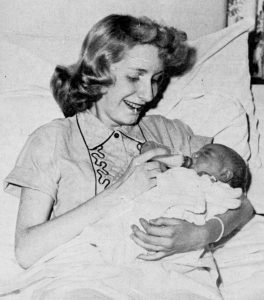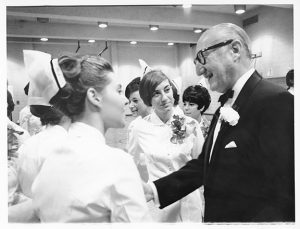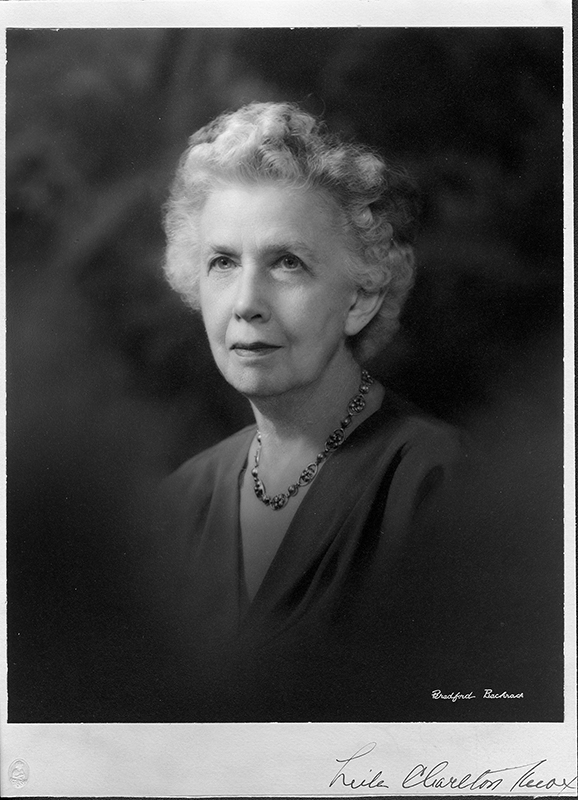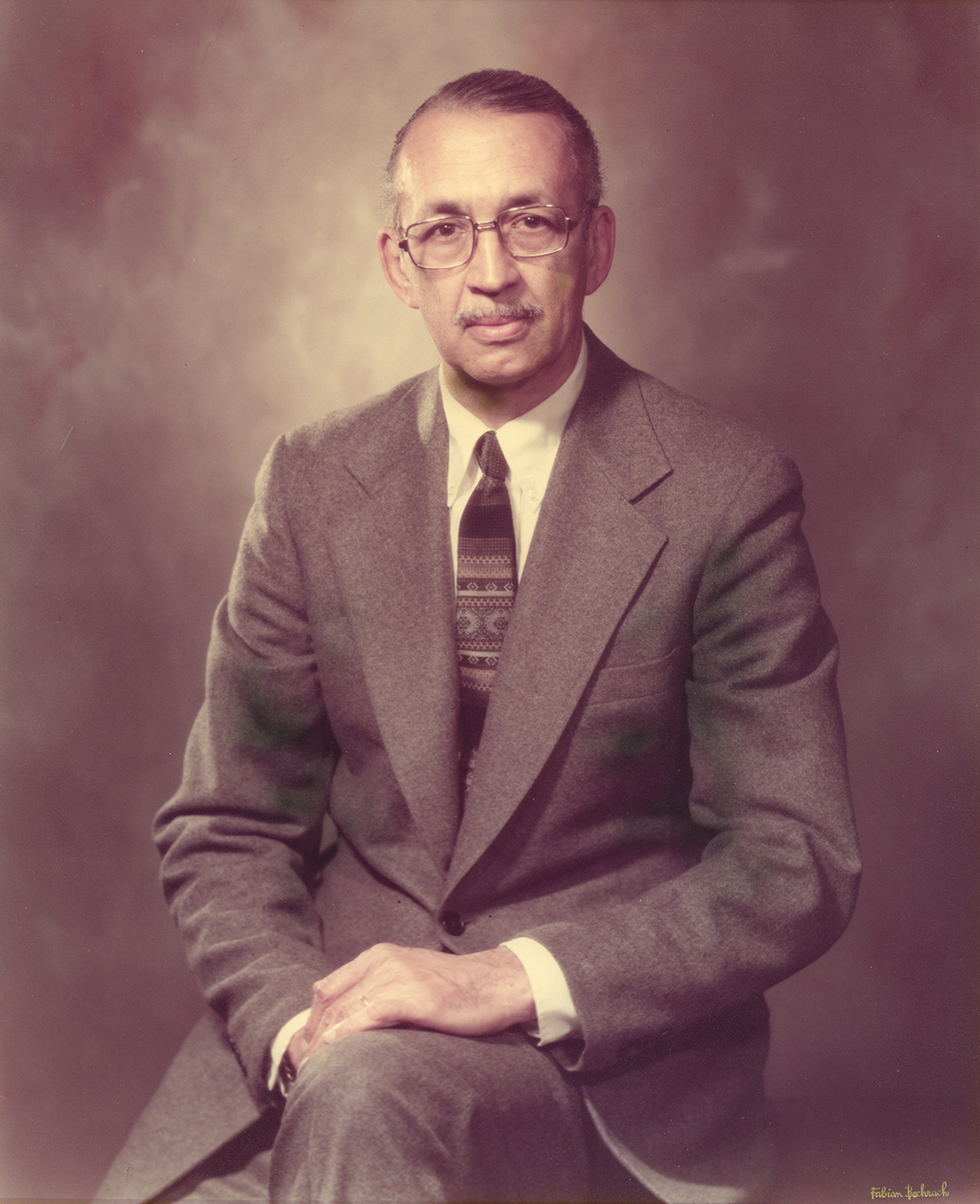Nov 26, 2019
 November is an important month in the life of Mount Sinai West. The Hospital’s founder, James H. Roosevelt, was both born on the 10th in 1800 and died on the 30th in 1864. Additionally, the Hospital’s doors opened on the 2nd in 1871. And in November 1964, the then Roosevelt Hospital inaugurated its first Obstetrical Service. Prior to this such a service was deemed unnecessary as its neighbors included the Sloane Hospital for Women and the Nursery & Child’s Hospital. However, in 1928, Sloane moved uptown to join the new Columbia-Presbyterian Medical Center and in 1934, Nursery & Child’s merged with New York Hospital, leaving an obstetrical service vacuum on the west side of Manhattan.
November is an important month in the life of Mount Sinai West. The Hospital’s founder, James H. Roosevelt, was both born on the 10th in 1800 and died on the 30th in 1864. Additionally, the Hospital’s doors opened on the 2nd in 1871. And in November 1964, the then Roosevelt Hospital inaugurated its first Obstetrical Service. Prior to this such a service was deemed unnecessary as its neighbors included the Sloane Hospital for Women and the Nursery & Child’s Hospital. However, in 1928, Sloane moved uptown to join the new Columbia-Presbyterian Medical Center and in 1934, Nursery & Child’s merged with New York Hospital, leaving an obstetrical service vacuum on the west side of Manhattan.
Hints of change started in July 1955 when Roosevelt Hospital’s President of the Board of Trustees, Garrard B. Winston, died and bequeathed nearly $4 million to the hospital. The Trustees decided to use the bequest to fund a much needed new building that would be named after Winston to honor his dedication to the Hospital. The construction of the building began in 1958, after demolition of the original Administration Building was complete.
In October of 1958, The Ambrose Monell Foundation presented the Hospital with a gift of one million dollars to construct an obstetrical floor and establish a much needed Obstetrical Service. The gift was arranged through Board member Edmund C. Monell, as a memorial to his mother, the late Maude Monell Vetlesen, who served as an honorary member of the Board of Trustees from March 1956 until her death in May of 1958. Mrs. Vetlesen also had a particular interest in obstetrical care. Occasionally its place in the training of physicians and nurses was the topic of conversation between her and several hospital professionals with whom she had an acquaintance. The floor would be called The Maude Monell Vetlesen Maternity Pavilion.
In 1961 the cornerstone was laid for the 12-story Garrard Winston Memorial Building. At the end of that year, Dr. Ralph W. Gause was appointed the first Chief of the Obstetrical Department. He began the process of building the department so it would be ready for full time operation when the Winston Building was opened.
The Winston Building opened in September of 1964, and the Obstetrical Department was inaugurated in November of that year. When in full operation, the OB Department expected to care for about 125 deliveries a month, and included antepartum and postpartum clinics. The first birth, a boy named Daniel Winston Maurer, took place on November 17th, and was celebrated with the gift of an engraved silver cup, as was the first girl’s birth when Doreen Ann Dichiora was born a few days later. There were 20 more deliveries by the end of that year. In 1965, the Department of Obstetrics and Gynecology completed its first full year with a record total of 1,004 gynecological operations and 597 deliveries.
Oct 14, 2019
Thirty-five years ago, on October 3, 1984, the Beth Israel Hospital School of Nursing was renamed and dedicated as the Phillips Beth Israel School of Nursing, in honor of Seymour Phillips. Mr. Phillips (1903-1987) served as chairman of the School of Nursing Board for almost 40 years. He watched over the School through a myriad of changes, in nursing, in Beth Israel, and the world. He also was a tremendous supporter of the Hospital itself, in particular supporting cardiac care and surgery. Mr. Phillips was the grandson of the founder of Phillips-Van Heusen Corporation and actively worked at the company from 1924-1967.

Seymour Phillips greeting members of the Beth Israel Class of 1968
Serving Beth Israel was a Phillips family tradition that stretched before Seymour Phillips and after him as well. Their name continues to be associated through the Phillips Ambulatory Care Center, the Phillips Family Practice, the Phillips Health Sciences Library and, of course, the Phillips Beth Israel School of Nursing.
As noted in the centennial history of the School of Nursing:
At every school of nursing graduation, Seymour Phillips stood at the podium and gave a rousing, inspiring speech for the graduates. He would turn his back to the audience and directly address the new nurses seated on the stage, as if no one else was in the auditorium. The students did not need to be told how much Phillips cared for them. His actions spoke louder than his eloquent words.
When Seymour Phillips died on 1987, Rose Muscatine Hauer, [then] Dean Emeritus…was one of the speakers at the service at Temple Emmanuel…. Hauer stepped to the podium to address the audience. As she looked up to speak, 200 nursing students in uniform – their starched white caps at attention – rose from their seats to honor their dear friend and long-time patron.
Apr 30, 2019
 March is Woman’s History month and there are many notable women from within the MSSL fold to honor, but Dr. Leila C. Knox is the first notable woman I would like to highlight for Women’s History Month. Dr. Knox was the first woman to be hired as an Attending Physician on any level at St. Luke’s Hospital. Leila Knox, BA started at St. Luke’s in 1913 as an assistant and bacteriologist to Resident Pathologist Dr. J. Gardiner Hopkins. At that time, it wasn’t uncommon for educated women to work in the Pathology Labs. But long-time Director of Pathology, Dr. Francis C. Wood knew Knox wanted more out of her work and encouraged her to attend medical school. She enrolled in Cornell University Medical College. She became the Resident Pathologist at St. Luke’s in 1917, and in 1918 she added ‘MD’ to that title. Working together, she and Dr. Wood developed a surgical pathology lab of importance and value, and one which was notable in its field. She was appointed Assistant Attending Physician in 1923, a title which was unique at that time. Knox wasn’t restricted to laboratory work, but trained technicians and members of the House Staff, conducted autopsies, and made rounds as an Attending to observe patients. She published many papers generated by her efforts both as an Attending and a Pathologist, and was Assistant Editor of the American Journal of Cancer from 1930-1938, writing abstracts and original articles for the publication. She was recognized abroad and at home for her work as a tissue diagnostician. She retired in 1948 after thirty years of service, holding the title of Pathologist, Director of Laboratories and Associate Attending Physician.
March is Woman’s History month and there are many notable women from within the MSSL fold to honor, but Dr. Leila C. Knox is the first notable woman I would like to highlight for Women’s History Month. Dr. Knox was the first woman to be hired as an Attending Physician on any level at St. Luke’s Hospital. Leila Knox, BA started at St. Luke’s in 1913 as an assistant and bacteriologist to Resident Pathologist Dr. J. Gardiner Hopkins. At that time, it wasn’t uncommon for educated women to work in the Pathology Labs. But long-time Director of Pathology, Dr. Francis C. Wood knew Knox wanted more out of her work and encouraged her to attend medical school. She enrolled in Cornell University Medical College. She became the Resident Pathologist at St. Luke’s in 1917, and in 1918 she added ‘MD’ to that title. Working together, she and Dr. Wood developed a surgical pathology lab of importance and value, and one which was notable in its field. She was appointed Assistant Attending Physician in 1923, a title which was unique at that time. Knox wasn’t restricted to laboratory work, but trained technicians and members of the House Staff, conducted autopsies, and made rounds as an Attending to observe patients. She published many papers generated by her efforts both as an Attending and a Pathologist, and was Assistant Editor of the American Journal of Cancer from 1930-1938, writing abstracts and original articles for the publication. She was recognized abroad and at home for her work as a tissue diagnostician. She retired in 1948 after thirty years of service, holding the title of Pathologist, Director of Laboratories and Associate Attending Physician.
Apr 30, 2019
It is with great sadness that we share news of the passing of our dear friend and supporter Arthur H. Aufses, Jr., MD (1926-2019), one of the Mount Sinai Health System’s most respected physicians and Chairman Emeritus of The Ruth J. & Maxwell Hauser and Harriet & Arthur H. Aufses, Jr., MD Department of Surgery at The Mount Sinai Hospital, and Professor in Surgery as well as the Department of Population Health Science and Policy.

Arthur H. Aufses, Jr., MD, 1926-2019
An innovative leader who served as Chair of the Department of Surgery from 1974-1996, Dr. Aufses ushered in Mount Sinai’s adoption of laparoscopic surgery and oversaw the expansion of ambulatory surgery and the hospital’s transplant program. He organized the surgical team that performed the first liver transplant in New York State in 1988.
Within Mount Sinai, Dr. Aufses served as a mentor to many residents and fellows and helped to break down barriers for women and minority surgeons. Over the years, he received many Excellence in Teaching awards from the Icahn School of Medicine at Mount Sinai, as well as institutional honors, including the Alumni Association’s Jacobi Medallion, and the Alexander Richman Award for Humanism in Medicine. He was the holder of Mount Sinai’s Gold Headed Cane from 1982 to 1997. On 17 occasions, medical students selected Dr. Aufses to administer the Oath of Maimonides or the Oath of Hippocrates at commencement, and on three occasions he was chosen to serve as Commencement Grand Marshal. In May 2003, Dr. Aufses delivered the medical school’s commencement address and was awarded an honorary Doctor of Humane Letters.
In addition to publishing more than 235 research papers and book chapters—many on the topics of surgical education and inflammatory bowel disease—he held leadership roles in many professional organizations. These include the New York Academy of Medicine, the American College of Gastroenterology, the New York Surgical Society, the American College of Surgeons, and the American Surgical Association.
Dr. Aufses also had a keen interest in Mount Sinai’s long and storied history, and published two books on the subject with institutional archivist Barbara Niss. This House of Noble Deeds: The Mount Sinai Hospital, 1852-2002 (New York University Press, 2002), chronicled the 150-year history of The Mount Sinai Hospital, focusing on the accomplishments of the staff since its origin as The Jews’ Hospital in the City of New York. Teaching Tomorrow’s Medicine Today: The Mount Sinai School of Medicine, 1963-2003 (New York University Press, 2005), detailed the first forty years of the Icahn School of Medicine at Mount Sinai.
In April 2017, Dr. Aufses’ support of the Archives was made clear when the Mount Sinai Archives was formally dedicated as the Arthur H. Aufses, Jr. MD Archives.
The staff of the Arthur H. Aufses, Jr., MD Archives will miss Dr. Aufses’ kindness, sense of humor, and selfless service to Mount Sinai. Dr. Aufses was calm and steady in the operating room and in life. He delighted in his trainees’ achievements, and set an example of honesty, integrity, and loyalty for those who followed him. He was a true Mount Sinai Giant.

Feb 27, 2019
To celebrate Black History Month, we would like to bring William Johnson Trent, Jr. (1910-1993), to your attention. Trent was the first African-American elected to the Board of Trustees of St. Luke’s Hospital. He was an active member of the Board from 1965 to 1977 and served four years as the Board’s President from 1970 – 1974. He remained a concerned Honorary Trustee from the time of his resignation until his death from cardiac arrest in November, 1993.
Trent was born in North Carolina and raised in Atlanta, Georgia. He attended a private high school and graduated from Livingstone College in 1930. He went on to earn an MBA from the Wharton School, followed by graduate work in economics at the University of Chicago. Afterwards, he returned to North Carolina and taught for two years at Livingstone College and later at Bennet College, where he was also an Acting Dean for a year.
He was the son of an early organizer of the National Association for the Advancement of Colored People (NAACP). Trent, Sr.’s civil rights activism seems to have been passed down to Trent, Jr., who served as Adviser on Negro Affairs to the Secretary of the Interior Harold L. Ickes between 1939 and 1946, and played a part in desegregating national park facilities. Later he held the position of Race Relations Officer in the Federal Works Agency. President Franklin Delano Roosevelt invited Trent to be a part of an informal group of African-Americans, casually called the “Black Cabinet,” who served as public policy advisers to Roosevelt and his wife during Roosevelt’s administration.
Joining with Tuskegee Institute president Frederick D. Patterson, and educator and civil rights activist Mary McLeod Bethune, Trent was co-founder and Executive Director of the United Negro College Fund from its, start in 1944 until he left 1964, raising $78 million to support private black colleges and universities.
During the time Mr. Trent was on the St. Luke’s Board he was an Assistant Personnel Director, involved in training and personnel development at Time, Inc., retiring in 1975. He was also on the boards of the National Social Welfare Assembly of New York City, the African-American Institute, the New Rochelle Council for Unity, the Child Study Association of American, and Livingstone College. He served on the College Housing Advisory Committee, Housing and Home Finance Agency, the Advisory Committee on Governmental Operations for the City of New Rochelle and was on the Steering Committee of the African Scholarship Program of American Universities, Cambridge, Mass., and the Personnel Committee of International House, a Morningside Heights neighbor.
While Trent was a strong advocate for African-American causes, he had the ability to bring people of all color together to work for a worthy cause, which may have been what drew his nomination to the Board of Trustees at St. Luke’s Hospital and made him a beloved, and honored member of it.
 November is an important month in the life of Mount Sinai West. The Hospital’s founder, James H. Roosevelt, was both born on the 10th in 1800 and died on the 30th in 1864. Additionally, the Hospital’s doors opened on the 2nd in 1871. And in November 1964, the then Roosevelt Hospital inaugurated its first Obstetrical Service. Prior to this such a service was deemed unnecessary as its neighbors included the Sloane Hospital for Women and the Nursery & Child’s Hospital. However, in 1928, Sloane moved uptown to join the new Columbia-Presbyterian Medical Center and in 1934, Nursery & Child’s merged with New York Hospital, leaving an obstetrical service vacuum on the west side of Manhattan.
November is an important month in the life of Mount Sinai West. The Hospital’s founder, James H. Roosevelt, was both born on the 10th in 1800 and died on the 30th in 1864. Additionally, the Hospital’s doors opened on the 2nd in 1871. And in November 1964, the then Roosevelt Hospital inaugurated its first Obstetrical Service. Prior to this such a service was deemed unnecessary as its neighbors included the Sloane Hospital for Women and the Nursery & Child’s Hospital. However, in 1928, Sloane moved uptown to join the new Columbia-Presbyterian Medical Center and in 1934, Nursery & Child’s merged with New York Hospital, leaving an obstetrical service vacuum on the west side of Manhattan.

 March is Woman’s History month and there are many notable women from within the MSSL fold to honor, but Dr. Leila C. Knox is the first notable woman I would like to highlight for Women’s History Month. Dr. Knox was the first woman to be hired as an Attending Physician on any level at St. Luke’s Hospital. Leila Knox, BA started at St. Luke’s in 1913 as an assistant and bacteriologist to Resident Pathologist Dr. J. Gardiner Hopkins. At that time, it wasn’t uncommon for educated women to work in the Pathology Labs. But long-time Director of Pathology, Dr. Francis C. Wood knew Knox wanted more out of her work and encouraged her to attend medical school. She enrolled in Cornell University Medical College. She became the Resident Pathologist at St. Luke’s in 1917, and in 1918 she added ‘MD’ to that title. Working together, she and Dr. Wood developed a surgical pathology lab of importance and value, and one which was notable in its field. She was appointed Assistant Attending Physician in 1923, a title which was unique at that time. Knox wasn’t restricted to laboratory work, but trained technicians and members of the House Staff, conducted autopsies, and made rounds as an Attending to observe patients. She published many papers generated by her efforts both as an Attending and a Pathologist, and was Assistant Editor of the American Journal of Cancer from 1930-1938, writing abstracts and original articles for the publication. She was recognized abroad and at home for her work as a tissue diagnostician. She retired in 1948 after thirty years of service, holding the title of Pathologist, Director of Laboratories and Associate Attending Physician.
March is Woman’s History month and there are many notable women from within the MSSL fold to honor, but Dr. Leila C. Knox is the first notable woman I would like to highlight for Women’s History Month. Dr. Knox was the first woman to be hired as an Attending Physician on any level at St. Luke’s Hospital. Leila Knox, BA started at St. Luke’s in 1913 as an assistant and bacteriologist to Resident Pathologist Dr. J. Gardiner Hopkins. At that time, it wasn’t uncommon for educated women to work in the Pathology Labs. But long-time Director of Pathology, Dr. Francis C. Wood knew Knox wanted more out of her work and encouraged her to attend medical school. She enrolled in Cornell University Medical College. She became the Resident Pathologist at St. Luke’s in 1917, and in 1918 she added ‘MD’ to that title. Working together, she and Dr. Wood developed a surgical pathology lab of importance and value, and one which was notable in its field. She was appointed Assistant Attending Physician in 1923, a title which was unique at that time. Knox wasn’t restricted to laboratory work, but trained technicians and members of the House Staff, conducted autopsies, and made rounds as an Attending to observe patients. She published many papers generated by her efforts both as an Attending and a Pathologist, and was Assistant Editor of the American Journal of Cancer from 1930-1938, writing abstracts and original articles for the publication. She was recognized abroad and at home for her work as a tissue diagnostician. She retired in 1948 after thirty years of service, holding the title of Pathologist, Director of Laboratories and Associate Attending Physician.
